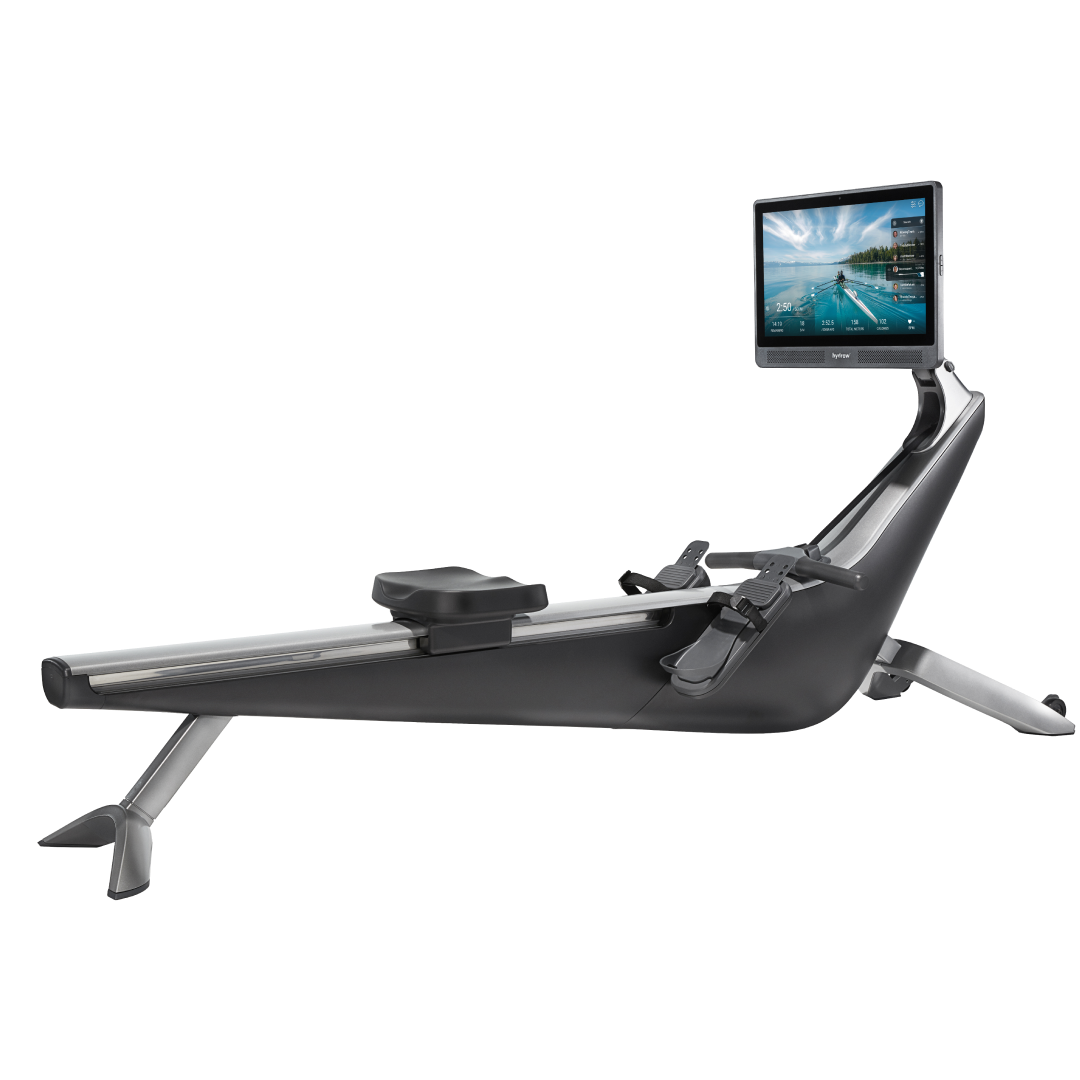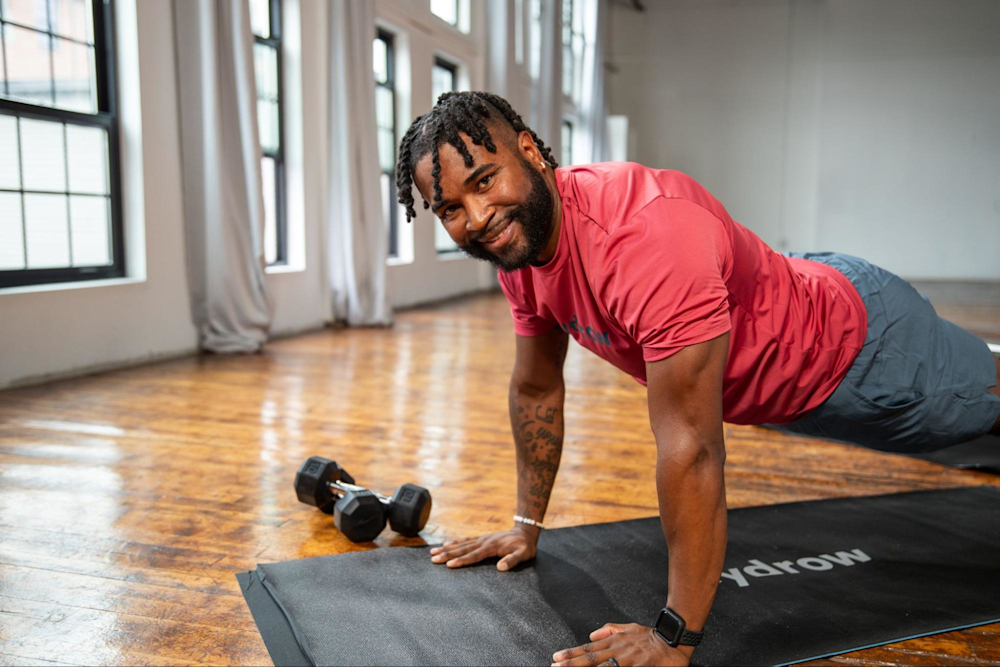12 Beginner Strength Training Exercises to Add to Your Workout Routine

Strength training delivers tons of benefits, including better mobility, fewer falls, more ease performing everyday tasks, and longer lifespans, according to the Centers for Disease Control and Prevention. Sounds pretty good, doesn’t it? That’s why the Physical Activity Guidelines for Americans from the U.S. Department of Health and Human Services recommend all adults get at least two days a week of muscle strengthening for all major muscle groups.
That said, strength training for beginners can feel a little intimidating. At Hydrow, we’re here to support you: Keep reading for some of the most beginner-friendly strength exercises to try and tips for adding them into your fitness routine, including:
Let’s jump in!
12 beginner strength training exercises to add to your workout routine
Beginner strength training should generally focus on full-body workouts that challenge all your major muscle groups. You can do many beginner-friendly strength exercises using just your body weight, but you can also add resistance, like dumbbells, kettlebells, and resistance bands.
These exercises are generally safe for beginners to try, but it’s always a good idea to check in with your doctor, expert trainer or strength coach before starting any new exercise program.
1. Squats
This lower-body exercise builds strength in your glutes and hamstrings and makes it easier to stand up from sitting down. Beginners can start with just their body weight. When bodyweight squats start to feel easy, you can hold a dumbbell in each hand.
Start standing with your feet slightly wider than your hips with your feet slightly turned out. This position helps accommodate the hip and knee function during the squat exercise.
Bend your knees as your hips move back and down, as if you were about to sit down on a chair. Keep your chest lifted, your back straight, and your knees tracking over your toes.
Continue lowering down until your thighs are parallel with the ground, or as low as you can comfortably go while maintaining good form. Make sure your knees aren’t caving in but instead remain over your toes throughout the entire movement.
Press through your feet to return to standing.
Squeeze your glutes at the top of the movement.
Maintain an engaged core/trunk to support your back.
Continue for your desired number of repetitions.
Tip: When you’re first learning proper squat form, you can do this exercise with a chair behind you. Gently tap your glutes to the chair on each rep, then stand back up.
2. Forearm planks
A plank is considered an isometric exercise: That means you’re building strength while holding a static position. Primarily a core exercise, planks also strengthen your arms, shoulders, and glutes.
Lie on your stomach on a yoga mat or other cushioned surface.
Prop yourself up on your toes and your forearms, with your elbows right under your shoulders.
Lift your body until you form a straight line from your heels to your hips to your head. Don’t let your hips sag or lift them too high.
Hold this position for your desired amount of time.
Tip: You can also do a full plank by balancing on your toes and your palms, with your hands on your mat right under your shoulders. If it bothers your shoulders or wrists, stick to the forearm plank.

Did You Know?
Over 90% of Hydrow members are still active one year later.
3. Step-up exercises
This functional exercise builds leg and glute strength, which can take pressure off achy knees. It also helps with balance.
Stand in front of a staircase at home or an aerobics step or box at the gym.
Step your right foot up onto your surface of choice.
Press through your right heel to lift your whole body up and stand fully on the step.
Step your left foot down onto the floor.
Return your right foot to the floor.
Continue for your desired number of reps. Then switch sides: Repeat for the same number of reps stepping up with your left foot first.
4. Biceps curls
A classic arm-strengthening exercise, the biceps curl can be done with dumbbells, a resistance band anchored under your feet, or items you have around the house, such as water bottles.
Start standing tall, with your feet planted shoulder-width apart, holding a weight in each hand by your sides, palms facing upwards.
Engage your core and squeeze your arm muscles as you curl the weights toward your shoulders.
Slowly and with control, lower the weights back down to the starting position.
Continue for your desired number of reps.
5. Wall push-ups
A full push-up often feels challenging for beginners. This modified version of the total-body move still strengthens from head to toe.
Start standing about two feet from a wall. Place your hands on the wall at chest height and just outside your shoulders.
Lean into your hands on the wall so your body forms a diagonal line, set up in a way that’s similar to the plank exercise.
Bend your elbows at about 45-degree angles from your torso as you bring your chest toward the wall.
When you’re as close as you can get, press through your palms to push your body away from the wall.
Continue for your desired number of reps.
Tip: As you build strength, you can make this harder by trying an incline push-up. Place your hands on a counter, couch, or box at the gym and follow the same instructions above. When you’re ready, you can try a full push-up with your palms on the floor. Again, remember to maintain an engaged core to support your spine.
6. Bent-over rows
Many beginners make the common mistake of focusing on building strength only in the muscles on the front of the body. They’re the easiest ones to see, after all! But it’s also important to build strength in the posterior chain (i.e., the back of your body). This is critical in supporting day-to-day movement and protecting against the risk of injury. This beginner-friendly strength exercise will help you work the muscles of your back, shoulders, and arms.
Start standing with your feet shoulder-width apart and a dumbbell (or water bottle) in each hand by your sides, palms facing each other, with a slight bend in your knees.
Hinge from the hips until you’re in a comfortable position (ideally at 45 degrees or more).
While maintaining a long spine, let your weights hang in front of you.
Squeeze your shoulder blades together to pull the weights toward your chest, keeping your elbows close to your ribs. Pause here briefly.
Slowly and with control, lower the weights back down to the starting position.
Continue for your desired number of reps.
7. Glute bridges
Another important muscle group on the backside of your body are your glutes. These muscles make up your rear end and power your movements like walking, running, and rowing. A glute bridge also works your core and hamstrings.
Start lying down on your back on a mat or other cushioned surface.
Bend your knees and plant your feet about six inches from your butt. Your arms can be flat by your sides.
Engage your core by tilting your pelvis slightly forward.
Press through your heels to lift your hips until your body forms a diagonal line from your knees to your hips to your shoulders. Pause here briefly.
Slowly and with control, lower your hips back down.
Continue for your desired number of reps.

Cardio and Strength, Combined
Burn calories and build muscle with a Hydrow rowing machine.
8. Overhead presses
In order to continue grabbing a dish from that high shelf in your kitchen or putting your carry-on into the overhead compartment on a plane, you’re going to want to build strength in the back, arm, and shoulder muscles responsible for pressing things over your head. This exercise helps you train for those movements.
Start standing tall with your feet planted shoulder-width apart holding a dumbbell (or water bottle) in each hand in front of your shoulders at shoulder height, palms facing away from you.
Press the weights directly over your head without locking out your elbows. The weights should almost touch each other above you.
Slowly and with control, lower the weights back down to your shoulders.
Continue for your desired number of reps.
9. Triceps extensions
Build strength and muscle tone on the back of your arms with this beginner strength training workout.
Start standing tall with your feet planted shoulder-width apart holding a single weight over your head.
Keeping your upper arms steady and close to your ears, bend your elbows to lower the weight behind your head.
Press the weight back up to the starting position.
Continue for your desired number of reps.
10. Mini band lat pulldowns
A well-rounded beginner’s strength training workout includes exercises with both pushing and pulling motions. A lat pulldown—which you can also do on a machine at the gym—targets the pulling muscles in your back, called the latissimus dorsi. If you don’t have a mini loop resistance band, you can do this move with just your body weight.
Start standing tall with your feet planted shoulder-width apart.
Loop a mini resistance band around your wrists.
Raise your arms over your head with your palms facing away from you. Position your hands about shoulder-width apart so there’s tension on the band.
Pull your shoulder blades together and bend your elbows to pull the band apart and down toward your chest.
Pause here briefly.
Slowly and with control, return your hands above your head without locking out your elbows.
Continue for your desired number of reps.
11. Alternating reverse lunges
Forward lunges can place a little too much pressure on the knees for some people, so it’s a smart move as a beginner to start with a reverse lunge instead. You’ll strengthen your entire lower body and your core while improving your balance. Beginners can start with just their body weight. When bodyweight lunges start to feel easy, you can hold a dumbbell in each hand.
Start standing tall with your feet planted shoulder-width apart.
Step your right foot about two feet behind you.
Bend both knees as you lower your body toward the floor.
Continue lowering until both knees form 90-degree angles. Your right knee should almost touch the ground. Make sure your left knee stays over your left foot.
Press through the heel of your left foot to lift back up, and bring your right foot back to the starting position.
Repeat on the other side, stepping back with your left foot.
Continue alternating sides for your desired number of reps.
12. Lateral raises
You can try this beginner-friendly arm and shoulder exercise without any weight at first. As you get stronger, you can try it with light dumbbells, water bottles, or canned food you have in your pantry.
Start standing tall with your feet planted shoulder-width apart and your arms by your sides, palms facing toward each other.
With a slight bend in your elbows, lift your arms straight out to your sides until about shoulder level.
Pause here briefly.
Slowly and with control, lower your arms back down to your sides.
Continue for your desired number of reps.
Tips for including strength training exercises in your workout routine
Aim to strength train all your major muscle groups at least twice a week. Generally, you can start with 10 to 15 repetitions or 30 seconds of each exercise, according to the American Council on Exercise. Aim for at least one set, but you can do two or three if you’re feeling up for it. Always start with a light weight to see how it feels before progressing.
Always warm up before strength training. This could involve a few minutes of walking or rowing to get your heart rate up or dynamic warm-up exercises like leg swings, arm circles, and torso twists to prepare your muscles and joints.
You should also aim to get at least 30 minutes of cardio exercise five times a week for optimal health, per the Physical Activity Guidelines for Americans. Pick a form of cardio you enjoy, whether it’s rowing, swimming, jogging, hiking, dancing, pickleball, or something else entirely!
An example beginner strength training routine
Choose four of the exercises above, aiming for a mix of upper- and lower-body moves with both pushing and pulling motions. Complete your desired number of repetitions for each exercise, rest for 30 to 90 seconds, then complete the next exercise. Continue until you’ve done all four moves. Rest for two minutes, then repeat the entire circuit for a second set (and then a third if you’re feeling strong!).
Another day that week, at least 48 to 72 hours later, according to the National Academy of Sports Medicine, do the same workout or pick four different exercises and complete a new circuit.
For example:
Monday:
Squats
Wall push-ups
Forearm planks
Mini band lat pulldowns
Thursday:
Reverse lunges
Bent-over rows
Glute bridges
Lateral raises
If crafting that plan is a little more than you bargained for, check out Hydrow’s guided strength-training routines. Our extensive library of strength training workouts has something for everyone, and the instruction from our elite Athletes will help you learn and progress safely and effectively.
Learn more about Hydrow’s strength training workouts today!

Explore Hydrow's library of 5,000+ rowing, circuit training, yoga, Pilates, and mobility workouts.



